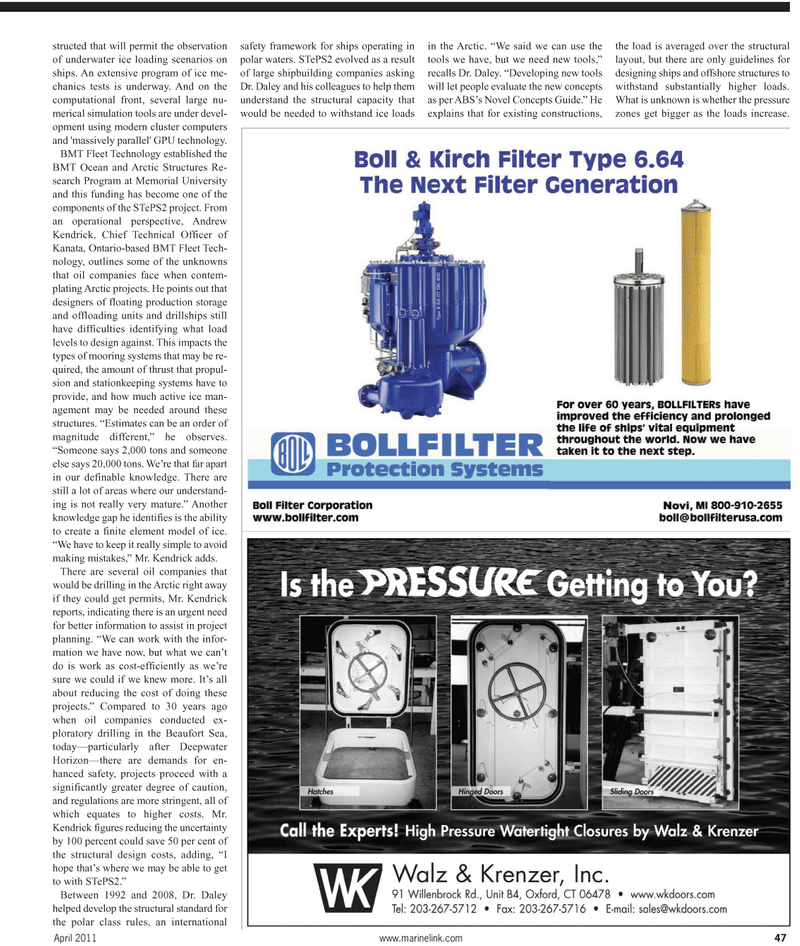
Page 3rd Cover: of Maritime Reporter Magazine (April 2011)
Offshore Annual
Read this page in Pdf, Flash or Html5 edition of April 2011 Maritime Reporter Magazine
April 2011 www.marinelink.com 47 structed that will permit the observation of underwater ice loading scenarios on ships. An extensive program of ice me- chanics tests is underway. And on the computational front, several large nu- merical simulation tools are under devel- opment using modern cluster computers and 'massively parallel' GPU technology.
BMT Fleet Technology established the
BMT Ocean and Arctic Structures Re- search Program at Memorial University and this funding has become one of the components of the STePS2 project. From an operational perspective, Andrew
Kendrick, Chief Technical Officer of
Kanata, Ontario-based BMT Fleet Tech- nology, outlines some of the unknowns that oil companies face when contem- plating Arctic projects. He points out that designers of floating production storage and offloading units and drillships still have difficulties identifying what load levels to design against. This impacts the types of mooring systems that may be re- quired, the amount of thrust that propul- sion and stationkeeping systems have to provide, and how much active ice man- agement may be needed around these structures. “Estimates can be an order of magnitude different,” he observes. “Someone says 2,000 tons and someone else says 20,000 tons. We’re that far apart in our definable knowledge. There are still a lot of areas where our understand- ing is not really very mature.” Another knowledge gap he identifies is the ability to create a finite element model of ice. “We have to keep it really simple to avoid making mistakes,” Mr. Kendrick adds.
There are several oil companies that would be drilling in the Arctic right away if they could get permits, Mr. Kendrick reports, indicating there is an urgent need for better information to assist in project planning. “We can work with the infor- mation we have now, but what we can’t do is work as cost-efficiently as we’re sure we could if we knew more. It’s all about reducing the cost of doing these projects.” Compared to 30 years ago when oil companies conducted ex- ploratory drilling in the Beaufort Sea, today—particularly after Deepwater
Horizon—there are demands for en- hanced safety, projects proceed with a significantly greater degree of caution, and regulations are more stringent, all of which equates to higher costs. Mr.
Kendrick figures reducing the uncertainty by 100 percent could save 50 per cent of the structural design costs, adding, “I hope that’s where we may be able to get to with STePS2.”
Between 1992 and 2008, Dr. Daley helped develop the structural standard for the polar class rules, an international safety framework for ships operating in polar waters. STePS2 evolved as a result of large shipbuilding companies asking
Dr. Daley and his colleagues to help them understand the structural capacity that would be needed to withstand ice loads in the Arctic. “We said we can use the tools we have, but we need new tools,” recalls Dr. Daley. “Developing new tools will let people evaluate the new concepts as per ABS’s Novel Concepts Guide.” He explains that for existing constructions, the load is averaged over the structural layout, but there are only guidelines for designing ships and offshore structures to withstand substantially higher loads.
What is unknown is whether the pressure zones get bigger as the loads increase.

 46
46

 4th Cover
4th Cover
